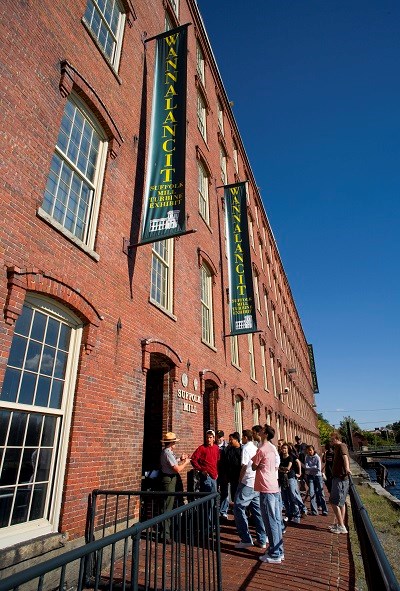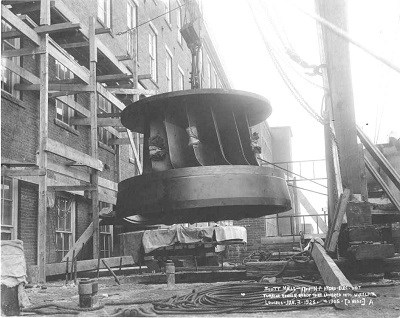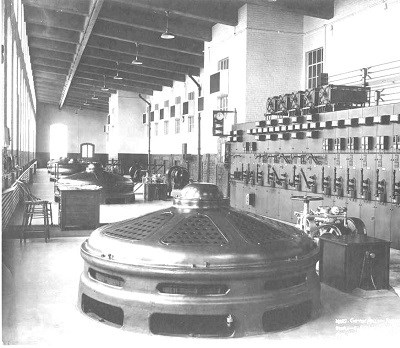
Jim Higgins IntroductionThe Suffolk Mills survive today as a reminder of Lowell’s once-great cotton textile industry. The Suffolk Mills Turbine Exhibit tells the story of how water provided power for the mills. It also highlights the changes in waterpower technology and the important work of Lowell’s nationally renowned engineers, whose turbine designs are still used today. Mills and WaterpowerThroughout much of the 19th century, American manufacturers favored waterpower over steam to run machinery in their factories. Of the many waterpower developments, the one on the Merrimack River at Lowell, Massachusetts, proved highly important in industrializing America. Investors in Lowell’s mills selected the Merrimack site because of the abundant waterpower potential at Pawtucket Falls, where, over the course of one mile, the river plunged 32 feet. In 1822, workers began constructing a power canal system that became one of the largest of its kind in the world. Soon after completing the canals and first mill buildings in 1823, Lowell was the nation’s leading producer of textiles and employed the largest number of factory workers in America. 
Suffolk MillsIncorporated in 1831, the Suffolk Manufacturing Company constructed a cotton textile mill on the Western Canal. On the opposite side of this waterway stood the Tremont Mills. Both millcomplexes were completed in 1832. About 40 years later the two companies merged and formed the Tremont and Suffolk Manufacturing Company. The appearance of the Suffolk Mills changed radically over its 100 years of operation as older buildings were replaced with newer ones. The most dramatic alterations occurred during the Civil War when the North and South severed the cotton trade. Realizing that they could gain greater profits by selling their raw cotton than by weaving cloth, Lowell's mill owners emptied their cotton warehouses and closed their mills. After the Suffolk Manufacturing Company closed the factory, it tore down most of the original mill buildings and constructed a more modern factory. It opened again soon after the end of the Civil War. Today, the only surviving building of the original 1830s construction is the countinghouse, which served as the mill agent’s office. 
Belts and PulleysTo provide power for the Suffolk Mills’ machinery, water from the Western Canal flowed through an opening in the wall of the mill and fell onto a large waterwheel mounted in the basement. The weight of the falling water turned the wheel, converting the potential energy, or stored energy, of falling water into kinetic energy, or moving energy. To transfer power from the waterwheel to the textile machines, the earliest mills used a network of rotating gears and shafting. This method tended to be slow, noisy, and jarring, with frequent breakdowns. In 1828, Lowell master mechanic Paul Moody devised a leather belt and pulley system. A drive pulley or flywheel to transferred power from a main shaft to smaller line shafts, and then to the machines. The use of belts and pulleys allowed for a smoother and more efficient transfer of power with fewer breakdown periods. Soon, drive pulleys and leather belting became standard in mills throughout the United States. 
TurbinesIn 1837 a young, British-born engineer, James Bicheno Francis, became chief engineer of the company that owned and operated Lowell’s waterpower system. Francis sought more precise methods of measuring water used by the mills, but also undertook studies to find more efficient “hydraulic motors” for harnessing waterpower. In the 1840s, he and Boston-based consulting engineer Uriah Boyden began experimenting with a new kind of waterwheel, called a turbine, that originated from the work of French engineers and Boyden. The original waterwheels, known as breastwheels, that powered Lowell’s mills rotated when water poured onto them and filled their buckets. The weight of the falling water on the buckets thus drove the wheels. By contrast, turbines rotated as the falling water was conducted into them, striking the metal vanes that spiraled around a central shaft. Whereas breastwheels achieved efficiencies of at most 65%, the turbines tested by Francis and Boyden reached an efficiency of 88%. Francis continued experimenting with turbines, refining the design of an inward-flow turbine developed by an American named Samuel Howd in 1838. Francis' experiments on turbines led to the mixed-flow reaction turbine, which became the American standard. The widely used “Francis turbine” was named in his honor. To international acclaim, Francis published his important work on hydraulic engineering in The Lowell Hydraulic Experiments in 1855. Beginning in 1853, the Suffolk Manufacturing Company began installing turbines designed by Uriah Boyden in the wheel pits of a new picker house. Although this picker house was demolished and Suffolk Mills’ Building #6 was constructed, the company retained the 1853 wheel pits. One of these wheel pits houses the turbine exhibit of Lowell National Historical Park. 
New Power SourcesBy the 1850s, tall, brick smokestacks began appearing alongside the mills in Lowell, signaling the arrival of steam power. The Suffolk Mills installed its first steam engine by 1860, allowing the factory to expand production without relying on waterpower. By 1875, Lowell’s mills used more steam power than waterpower. Newer, more efficient Francis turbines built by the Victor-Standard Company replaced the four original Boyden turbines in the Suffolk Mills. Installed in 1897, these turbines were half the size of the Boyden turbines, but equally powerful. The smaller size of these Francis turbines, which remain in place today, also permitted the installation of two turbines in each wheel pit, thus increasing power generation. By 1910, Lowell’s textile mills began to use hydroelectricity. Ten years later, the Suffolk Mills had installed several generators for this purpose. These generators were connected to the highspeed Victor-Standard turbines, continuing the use of waterpower into the 20th century. One of these generators is on display in the basement of the Suffolk Mills. The Tremont and Suffolk Manufacturing Company closed its doors and sold the facility in 1926. The mill continued to operate under various owners, ending its days in the textile industry as the Wannalancit Mill, which closed in 1981. Today, one restored turbine demonstrates how waterpower was harnessed and transferred to machinery. When operating, the turbine uses a 13-foot drop of water that flows through the penstock and into the turbine, causing it to rotate. The rotational motion is transferred through shafts, gears, belts, and pulleys to a power loom that represents the hundreds of looms that once operated there. A park ranger demonstrates the operation of this power loom during guided tours. |
Last updated: October 7, 2019
